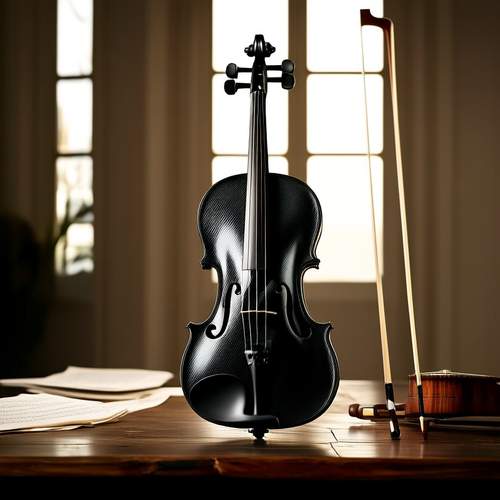The world of musical instruments has witnessed a quiet revolution over the past two decades, one that has largely gone unnoticed by the general public. Carbon fiber, a material once reserved for aerospace engineering and high-performance sports equipment, has steadily infiltrated the realm of instrument craftsmanship. This advanced composite material is reshaping how instruments are made, played, and heard across genres from classical to contemporary music.
Traditionalists might raise an eyebrow at the thought of carbon fiber violins or cellos, but the material offers distinct advantages that wood simply cannot match. Unlike their wooden counterparts, carbon fiber instruments are virtually impervious to changes in temperature and humidity. This stability means musicians no longer need to worry about their prized possession warping or cracking during international tours or outdoor performances. The material's durability also makes it ideal for student musicians who might not yet have developed the careful handling habits required for delicate wooden instruments.
The acoustic properties of carbon fiber have surprised even the most skeptical audiophiles. When properly engineered, these instruments produce a tone that maintains the warmth and complexity of traditional materials while offering enhanced projection and clarity. Luthiers specializing in carbon fiber construction have developed techniques to mimic the vibrational characteristics of aged wood, resulting in instruments that satisfy both the player's touch and the listener's ear. The material's consistent density allows for unprecedented precision in soundboard thickness and bracing patterns, giving modern instrument makers control over tonal qualities that master craftsmen of previous centuries could only achieve through trial and error.
Carbon fiber's lightweight nature has opened new possibilities for instrument design. Wind players, particularly flutists and clarinetists, report reduced fatigue during long performances or practice sessions. The material's stiffness-to-weight ratio enables the creation of larger-bodied string instruments without the bulk typically associated with such sizes. This has led to innovations in bass instrument design, making them more portable without sacrificing sound quality. Some manufacturers have even experimented with ergonomic shapes that would be impossible to craft from wood, potentially revolutionizing how instruments interface with the human body.
The environmental impact of carbon fiber instruments presents a complex picture. On one hand, the material's longevity means fewer instruments end up in landfills. A well-maintained carbon fiber cello could theoretically last centuries without the deterioration that plagues wooden instruments. However, the production process remains energy-intensive, and the recycling of carbon fiber composites still poses significant challenges. Some forward-thinking manufacturers have begun incorporating recycled aerospace-grade carbon fiber into their instruments, while others are developing more sustainable production methods to reduce the carbon footprint of these already carbon-based instruments.
Professional musicians have been gradually embracing carbon fiber instruments, particularly in situations where reliability trumps tradition. Orchestral players performing outdoors, touring musicians facing unpredictable climates, and studio artists needing consistent recording tones all benefit from the material's stable nature. The jazz and folk worlds have shown particular interest, with carbon fiber guitars and mandolins gaining traction among performers who value both durability and distinctive tone. Even the world of electronic music has taken notice, as carbon fiber's resonant properties make it ideal for hybrid acoustic-electronic instruments.
Educational institutions are beginning to recognize the value of carbon fiber instruments in their music programs. The reduced maintenance requirements and lower long-term costs make them attractive options for school budgets. Students learning on carbon fiber instruments don't face the same limitations as those using worn-out wooden instruments that may have developed structural or tonal issues. This accessibility factor could potentially democratize music education, allowing more students to experience high-quality instruments regardless of their program's funding level.
The aesthetic possibilities of carbon fiber have expanded dramatically since the first utilitarian black instruments appeared on the market. Modern carbon fiber luthiers can create visually stunning instruments with woven patterns, colored resins, and even translucent sections that showcase the material's intricate structure. Some custom shops offer personalized weave patterns, turning each instrument into a unique work of art. This marriage of visual and acoustic artistry helps overcome the initial hesitation some musicians feel about moving away from traditional wood grains and finishes.
As the technology continues to evolve, carbon fiber instruments are finding their place alongside traditional wooden ones rather than replacing them entirely. Many professional musicians now maintain both types of instruments, choosing which to use based on performance conditions and musical requirements. The coexistence of centuries-old craftsmanship with cutting-edge material science represents an exciting new chapter in the history of musical instrument development. What began as an experiment in durability has blossomed into a legitimate alternative that expands rather than limits the musician's palette of expression.
Looking ahead, the integration of smart technologies with carbon fiber instruments appears inevitable. The material's conductive properties could enable built-in sensors for teaching applications or performance analysis. Some prototypes already incorporate piezoelectric elements that capture bowing techniques or fingering patterns for digital processing. As these technologies mature, carbon fiber may become the platform that bridges the gap between acoustic tradition and digital innovation in ways that wood never could.

By /May 30, 2025

By /May 30, 2025

By /May 30, 2025

By /May 30, 2025

By /May 30, 2025

By /May 30, 2025

By /May 30, 2025

By /May 30, 2025

By /May 30, 2025

By /May 30, 2025

By /May 30, 2025

By /May 30, 2025

By /May 30, 2025

By /May 30, 2025

By /May 30, 2025

By /May 30, 2025

By /May 30, 2025

By /May 30, 2025

By /May 30, 2025